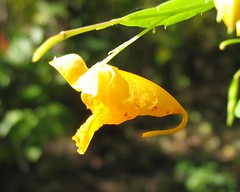 Jewelweed is a pretty flower, a sparkly wonder, a trailside snack, and a soothing skin treatment. What's not to love?
Jewelweed is a pretty flower, a sparkly wonder, a trailside snack, and a soothing skin treatment. What's not to love?There are actually two species of jewelweed in our area: Impatiens biflora, which has darker orange flowers, often in pairs, and Impatiens pallida, with paler yellow flowers. Both have darker orange or red spots. And yes, they are relatives of the common garden impatiens (the genus includes hundreds of species) -- but unlike the impatiens in my mom's yard, jewelweed can grow 3-5 feet tall.
 Water beads up on the dusky-colored leaves of jewelweed, creating sparkling jewels after a rain. According to Steve Brill, they also look beautiful underwater: the undersides of the leaves will turn silvery.
Water beads up on the dusky-colored leaves of jewelweed, creating sparkling jewels after a rain. According to Steve Brill, they also look beautiful underwater: the undersides of the leaves will turn silvery.The flowers and seeds of jewelweed are edible. But you'll have to be careful to collect any seeds. Another common name for jewelweed is "touch-me-not": the seedpods will explode when you touch them. Of course, this is fun in itself -- but if you surround the seedpod with your whole hand and squeeze, it should explode in your hand, and you can try the nutty little seeds.
Jewelweed also provides food for wildlife: the bright, trumpet-shaped flowers can attract hummingbirds and butterflies. If you sit by a patch for a little while, you're sure to at least see bees crawling inside the flowers for the nectar.
The flowers and seeds are just a little nibble for us humans. But jewelweed has been highly valued for centuries as a treatment for skin irritation. It turns out that it includes one of the active components of Preparation H. No special preparation is necessary -- just break a stem or crush up several leaves, and rub the juice on the irritated area.
 I have to admit, I have been something of a jewelweed doubter. It is said to soothe bee and wasp stings and mosquito bites -- though of course it's still more comforable to not get stung or bitten in the first place. I never could tell much of a difference after rubbing it on mosquito bites. But recently, I brushed against some stinging nettle, and immediately rubbed the sting with jewelweed. I do think the pain stopped much more quickly than in my previous stinging nettle encounters. The two plants often grow side-by-side: both like moist areas.
I have to admit, I have been something of a jewelweed doubter. It is said to soothe bee and wasp stings and mosquito bites -- though of course it's still more comforable to not get stung or bitten in the first place. I never could tell much of a difference after rubbing it on mosquito bites. But recently, I brushed against some stinging nettle, and immediately rubbed the sting with jewelweed. I do think the pain stopped much more quickly than in my previous stinging nettle encounters. The two plants often grow side-by-side: both like moist areas.Jewelweed is also said to prevent a poison ivy rash, if you rub the area that has been exposed to poison ivy with jewelweed juices soon after exposure. Steve Brill also claims it can be used to soothe warts, bruises, fungal infections, burns, cuts, eczema, acne, and any other skin irritations; his website describes how to make a tincture or ointment to keep at home.
In the wild: Jewelweed is common in this area along streams and in wet areas, typically in partly shady areas.
In your yard: If you have a moist spot, you could try growing some. Jewelweed is said to be easy to start from seed (but we've never tried).
Like the photos in this post? Mouse over for credits; a click takes you to the photographer on Flickr.


